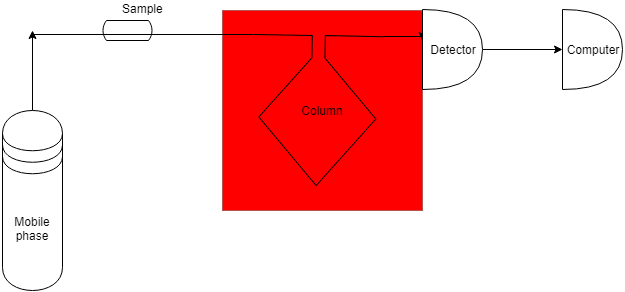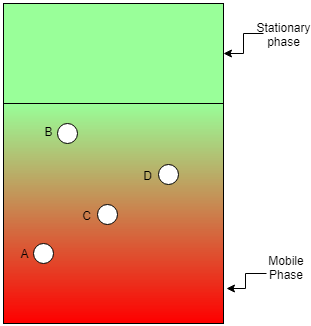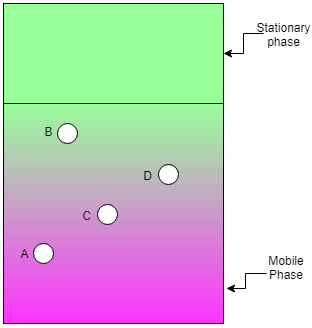This set of Biophysics Multiple Choice Questions & Answers (MCQs) focuses on “Partition Chromatography”.
1. On what basis, the samples of partition chromatography get separated?
a) Molecular weight
b) Partition Coefficient
c) Viscosity
d) Shape
View Answer
Explanation: On the basis of the partition coefficient, the samples of partition chromatography get separated. The partition coefficient is the ratio between the sample concentration in the upper phase and the sample concentration in the lower phase.
2. Which of the following option is the most suitable type of partition chromatography?
a) Liquid-Liquid chromatography
b) Gas-Liquid Chromatography
c) Liquid-Liquid chromatography and Gas-Liquid chromatography
d) Gas-Solid chromatography
View Answer
Explanation: Partition Coefficient can be two types Liquid – Liquid chromatography and Gas-Liquid Chromatography. This is because partition is a phenomenon between liquid and liquid or liquid and gas or gas and gas only. It’s not a property of solid.
3. After performing partition chromatography, the sample concentration in the upper phase is 50 and the sample concentration in the lower phase is 25. What will be the partition coefficient?
a) 2
b) 0.5
c) 4
d) 10
View Answer
Explanation: Partition coefficient K = the sample concentration in the upper phase / the sample concentration in the lower phase. So the partition coefficient is 50/25 = 2.
4. What is the basic principle of HPLC?
a) It is a liquid-solid partition chromatographic technique
b) It is a gas-gas partition chromatographic technique
c) It is a gas-solid partition chromatographic technique
d) It is a liquid-liquid partition chromatographic technique
View Answer
Explanation: HPLC is a technique to separate two liquids. Therefore, It is a liquid-liquid partition chromatographic technique.
5. Solid gas chromatography is a type of Partition chromatography.
a) True
b) False
View Answer
Explanation: The partition is of two types. It happens either between liquid and liquid or liquid and gas or gas and gas only. It’s not a property of solid substances.
6. What is the main principle requirement to perform HPLC?
a) The sample should be volatile
b) The sample should be nonvolatile
c) The sample should be immiscible
d) The sample should be liquid
View Answer
Explanation: To perform HPLC, the sample should be volatile. Because in HPLC, the samples are separated on the basis of the difference in their boiling point difference.
7. The following image is a diagrammatic demonstration of HPLC. Identify the red colored chamber in the following picture.

a) Motor
b) Cooling chamber
c) Controlled Heating chamber
d) Water supplier
View Answer
Explanation: The above image is a diagrammatic representation of HPLC. In HPLC, the samples are separated on the basis of the difference in their boiling point difference. Therefore a controlled heating chamber is used.
8. The following image is the demonstration of a Liquid-Liquid chromatography. Here an immiscible liquid stationary phase is embedded over solid support. Which sample is highly soluble in the liquid mobile phase?

a) Sample A
b) Sample B
c) Sample C
d) Sample D
View Answer
Explanation: If the sample is highly soluble in the mobile phase, it will move more distance with the mobile phase. Therefore, Sample B is the most soluble in the mobile phase as it traveled the longest distance.
9. The following image is the demonstration of a Liquid-Liquid chromatography where an immiscible liquid stationary phase is embedded over solid support. Rearrange the samples in the increasing order of solubility in the stationary phase.

a) B<D<C<A
b) B<D<A<C
c) B<A<C<D
d) A<D<C<B
View Answer
Explanation: More soluble in the stationary phase less distance traveled due to attraction with the stationary phase. So the proper arrangement of samples according to their solubility in the stationary phase is B<D<C<A.
10. The partition coefficient of a sample X is 2. The concentration of X in Stationary phase is 30 M, then what is the concentration of X in the mobile phase is __________________
a) 60 M
b) 30 M
c) 20 M
d) 10 M
View Answer
Explanation: Partition coefficient K = the sample concentration in upper phase (mobile phase) / the sample concentration in lower phase (stationary phase). So concentration of X in mobile phase = 30*2 = 60.
Sanfoundry Global Education & Learning Series – Biophysics.
To practice all areas of Biophysics, here is complete set of 1000+ Multiple Choice Questions and Answers.
If you find a mistake in question / option / answer, kindly take a screenshot and email to [email protected]
